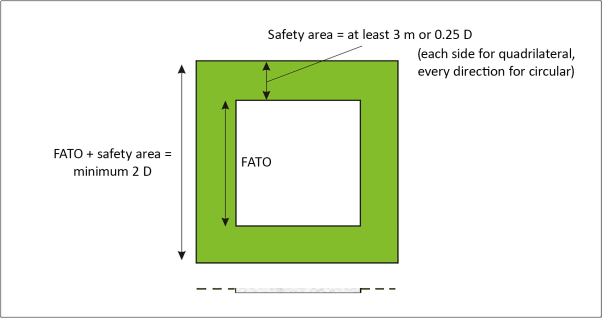CS HPT-DSN.B.100 Final approach and take-off areas (FATOs)
ED Decision 2019/012/R
(a) Applicability: A heliport should be provided with at least one final approach and take-off area (FATO).
(b) Location: A FATO in proximity to other infrastructure and objects should be located so as to minimise:
(1) the influence of the surrounding environment, including structure-induced turbulence;
(2) the influence of, and on, the surrounding traffic, including wake turbulence, where simultaneous aircraft operations are intended.
(c) Characteristics:
(1) A FATO should be obstacle-free; however, when collocated with the touchdown and lift-off area (TLOF), TLOF arrays of segmented point source lighting (ASPSL) or luminescent panels (LPs) with a height not more than 5 cm can be provided for the installation of visual aids.
(2) Where a FATO is intended to be used by helicopters operated in performance class 1, its dimensions should be as prescribed in the helicopter (aircraft) flight manual (HFM) except that, in the absence of width specifications, the width should be not less than the greatest overall dimension (D) of the largest helicopter the FATO is intended to serve.
(3) Where a FATO is intended to be used by helicopters operated in performance class 2 or 3, its dimensions should be of sufficient size and shape to contain an area within which a circle can be drawn of diameter not less than:
(i) 1 D of the largest helicopter when the maximum take-off mass (MTOM) of helicopters the FATO is intended to serve is more than 3 175 kg;
(ii) 0.83 D of the largest helicopter when the MTOM of helicopters the FATO is intended to serve is 3 175 kg or less.
(4) The surface of the FATO should:
(i) be resistant to the effects of rotor downwash;
(ii) be free of irregularities that would adversely affect the take-off or landing of helicopters;
(iii) have bearing strength sufficient to accommodate a rejected take-off by helicopters operated in performance class 1;
(iv) provide ground effect;
(v) have a mean slope in any direction which should not exceed 3 per cent; and
(vi) provide rapid drainage.
(5) No portion of a FATO should have a local slope exceeding:
(i) 5 per cent where the heliport is intended to be used by helicopters operated in performance class 1;
(ii) 7 per cent where the heliport is intended to be used by helicopters operated in performance class 2 or 3.
GM1 HPT-DSN.B.100 Final approach and take-off areas (FATOs)
ED Decision 2019/012/R
(a) General:
(1) A FATO may not be necessary to be provided at and aerodrome, where the runway is used for the purposes of final approach and take-off of helicopters.
(2) Where a FATO is located near a runway or taxiway, and when simultaneous helicopter and aeroplane operations are planned, the separation distance between the edge of a runway or taxiway and the edge of a FATO should not be less than the appropriate dimension in Table GM1-B-1.
(3) Operational limitations should be considered under certain wind conditions.
|
If aeroplane mass and/or helicopter mass are |
Distance between FATO edge and runway edge or taxiway edge |
|
up to but not including 3 175 kg |
60 m |
|
3 175 kg up to but not including 5 760 kg |
120 m |
|
5 760 kg up to but not including 100 000 kg |
180 m |
|
100 000 kg and over |
250 m |
|
Note: The values specified in this table are primarily intended to mitigate risks of wake turbulence encounters. In addition to this table, when positioning a FATO intended to be used simultaneously with a nearby runway or taxiway, attention should be given to other CS ADR-DSN requirements such as the minimum runway strip width. Local environment should be taken into account when setting the separation between the FATO and nearby infrastructure elements to ensure the safety of simultaneous operations. |
|
Table GM1-B-1. FATO minimum separation distance
(b) A FATO should not be located:
(i) near taxiway intersections or holding points where jet engine efflux is likely to cause high turbulence; or
(ii) near areas where aeroplane vortex wake generation is likely to occur.
CS HPT-DSN.B.110 Helicopter clearways
ED Decision 2019/012/R
(a) Applicability: When provided, a helicopter clearway should be located beyond the end of the FATO.
(b) Characteristics:
(1) The width of a helicopter clearway should not be less than that of the associated safety area (see Figure B-1).
(2) The ground in a helicopter clearway should not project above a plane having an upward slope of 3 per cent, commencing at the periphery of the FATO.
(3) An object situated in a helicopter clearway, which may endanger helicopters in the air, should be regarded as an obstacle and should be removed.
GM1 HPT-DSN.B.110 Helicopter clearways
ED Decision 2019/012/R
General: A helicopter clearway would need to be considered when the heliport is intended to be used by helicopters operating in performance class 1.
CS HPT-DSN.B.120 Touchdown and lift-off areas (TLOFs)
ED Decision 2019/012/R
(a) General:
(1) At least one TLOF should be provided at a heliport.
(2) One TLOF should be located within the FATO or one or more TLOFs should be collocated with helicopter stands.
(b) Characteristics:
(1) A TLOF should be of sufficient size to contain a circle of diameter of at least 0.83 D of the largest helicopter the area is intended to serve.
(2) Where the TLOF is within the FATO, the TLOF should be dynamic load-bearing.
(3) Where a TLOF is collocated with a helicopter stand, the TLOF should be static load-bearing and be capable of withstanding the traffic of the helicopters that the area is intended to serve.
(4) Slopes on a TLOF should be sufficient to prevent accumulation of water on the surface of the area and should not exceed 2 per cent in any direction.
(5) Where a TLOF is located within a FATO which can contain a circle of diameter more than 1 D, the centre of the TLOF should be located not less than 0.5 D from the edge of the FATO.
GM1 HPT-DSN.B.120 Touchdown and lift-off areas (TLOFs)
ED Decision 2019/012/R
Additional TLOFs may be located within runway-type FATOs.
ED Decision 2019/012/R
(a) General: A FATO should be surrounded by a safety area which need not be solid.
(b) Characteristics:
(1) A safety area surrounding a FATO should extend outwards from the periphery of the FATO for a distance of at least 3 m or 0.25 D, whichever is greater, of the largest helicopter the FATO is intended to serve and:
(i) each external side of the safety area should be at least 2 D where the FATO is quadrilateral (see Figure B-1); or
(ii) the outer diameter of the safety area should be at least 2 D where the FATO is circular.
(2) The surface of the safety area should be treated to prevent flying debris caused by rotor downwash.
(3) When solid, the surface of the safety area abutting the FATO should be continuous with the FATO.
(4) When solid, the surface of a safety area should not project above a plane having an upward slope of 4 per cent, commencing at the periphery of the FATO.
(5) From the outer edge of the safety area to a distance of 10 m there should be a protected side slope rising at 45 degrees.
(6) The protected side slope should not be penetrated by obstacles, except that when obstacles are located to one side of the FATO only, they may be permitted to penetrate the side slope surface.
(7) No mobile object should be permitted on a safety area during helicopter operations.
(8) No fixed object should be permitted above the plane of the FATO on a safety area, except for frangible objects which, because of their function, must be located on the area.
(9) Objects whose function requires them to be located on the safety area should not:
(i) if located at a distance of less than 0.75 D from the centre of the FATO, penetrate a plane at a height of 5 cm above the plane of the FATO; and
(ii) if located at a distance of 0.75 D or more from the centre of the FATO, penetrate a plane originating at a height of 25 cm above the plane of the FATO and sloping upwards and outwards at a gradient of 5 per cent.

Figure B-1. FATO and associated safety area
GM1 HPT-DSN.B.130 Safety areas
ED Decision 2019/012/R
When only a single approach and take-off climb surface is provided, the need for specific protected side slopes should be determined by a safety assessment.
